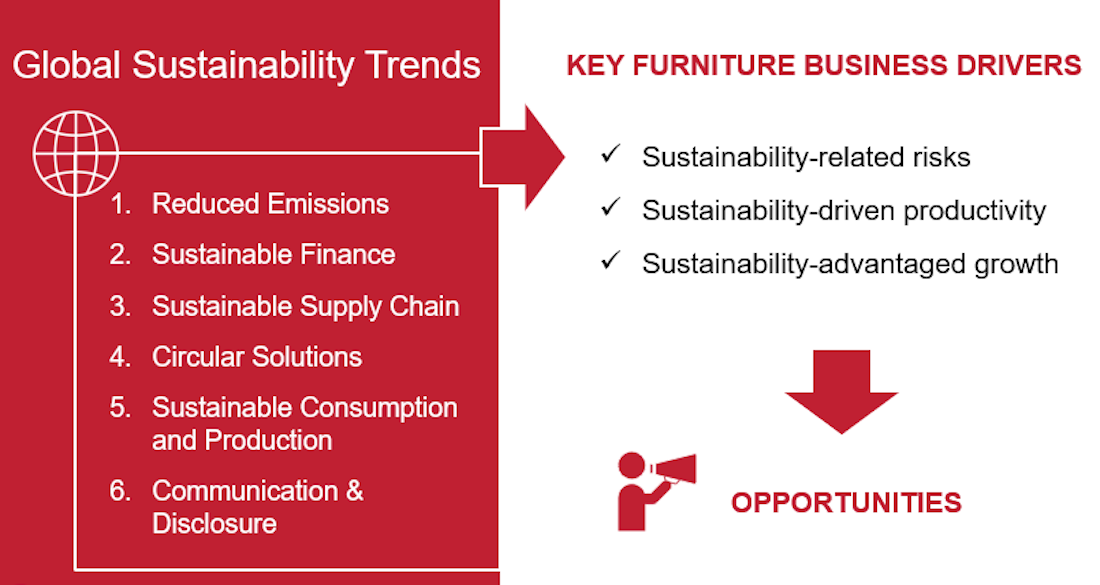
This third interview with Elena Veneziani (Environment and Sustainability Division of UL) concludes the synthesis of the emerged topics from the annual summit of the furniture sector organized by UL.
After having explained which are the five macro trends perceived in the global furniture market and having identified the so-called“drivers” of sustainability, she now highlights the opportunities eco-sustainability offers to manufacturing companies of the furniture sector.
Opportunities arise from risks. Risks, as we have seen, in some way, they are themselves the drivers that give rise to the opportunities, that we are going to disclose in part three of the furniture sustainability article series.
Before proceeding, a brief recap of which are the 5 global trends compared to the 3 risks / drivers on which we have focused previously.
What are the opportunities arising from the Emissions Reduction trend?
With the rise of mandatory carbon reporting and opportunities deriving from cost savings and reputational benefit, it is easy to understand, that managing carbon emission, is a must-do- activity. At the same time, supplier companies seem to struggle to find time to learn and create independently carbon footprints, and, at the same time, they lack the budget to pay for an external consultancy.
In response to that rising need UL introduced a new solution, named Turbo Carbon™ Software, which provides a simple, quick and affordable way for supply chain carbon accounting. The entire process can be done online and includes features that help improve the accuracy of data meeting carbon reporting needs that emerge from: Regulation – CDP – Customer requests.
What are the opportunities arising from the sustainable finance trend?
It can offer numerous opportunities as greater access to capital, financing and insurance and also access to new markets as the global eco-friendly furniture market, which was valued at 35.2 billion dollars in 2019 and is predicted to continuously grow in the future.
The key to the new generation of sustainable investing is that it focuses only on ESG (Environmental, Social, Governance) issues that impact a firm’s valuation. Relevance varies by industry.
The Sustainability Accounting Standards Board (SASB) has identified 77 industries including the furniture sector.
For example, relevant issues for furniture companies include energy management, management of chemicals in products, product lifecycle environmental impacts and wood supply chain management. Making assessments in the same universe of information and reporting on the sustainability topics that matter to most investors is key.
What are the opportunities arising from the Sustainable Supply Chain?
Being able to source from a sustainable supply chain, it offers the opportunity to reduce the risk of business interruptions, increase long-term profits and optimize costs. Therefore, the digitization of supply chain data is key.
UL’s 360 software is a very useful tool that can be used to consolidate entreprise complex information, reduce errors and missing documentation, mantaining records in a centralized digital system, enable information sharing among multiple stakeholders and provide easy access information for reporting compliance and auditing.
What are the opportunities arising from Circular Solutions?
Adopting circular-economy principles could not only benefit environmentally and socially but could also generate a net economic benefit of more than 1 trillion dollars.
It is major opportunity to increase resource productivity, decrease resource dependence and waste, and increase employment and growth.
Improve competitiveness and stir innovation leading to profitable growth. A great tool to measure and analyze circular economy efforts is the UL’s 3600 meta standard which evaluates circular economy at the product, facility and company level. Program deliverables include a report used to effectively communicate and report on progress in that area.
What are the opportunities arising from Sustainable Consumers?
The opportunities arising from sustainable consumption derive from consumers choosing brands, whose values align with their own.
We have seeing rapid growth in the sustainable furniture offers but are all green furniture claims true? Not always, and there’s a term for that: green washing.
So it’s important to place recognized and credible environmental labelling on products to help customers to make better-informed choices when shopping for eco-friendly furniture.
There is a considerable number of marks were single attributes are evaluated like the UL Environmental Claim validation program offers or multi-attributes certification, like LEVEL certification by BIFMA and these marks that can be definitely used as a differentiating factor impacting positively into consumer’s choices.
So is the furniture industry transitioning to increasingly sustainable value chains?
The furniture industry cannot ignore the demand from investors and customers and their expectations.
The five sustainable trends that we identified are interconnected to the nature of circular economy and low-carbon agendas.
Engaging sustainability is not only driven by the increasing policies and regulations, NGOs, industries associations, but the key drivers are the business opportunities at three levels:
Sustainability-related risks when managing climate issues for example;
Sustainability-driven productivity such as increasing efficiency of natural resources;
Sustainability-advanced Growth when creating a competitive advantage.
The truth is that there is no 100% right solution on sustainability. Each company must analyze their sustainable issues and prioritize a set of actions.
A good sustainability strategy requires to focus on investments and drive performance by engaging internal and external stakeholders.
Furthermore, there is a number of available and affordable tools that can support the furniture companies in their way to implement sustainability at all levels.
Finally, transparency is essential not only for the collection and analysis of data, but also for communicating the commitment and efforts in sustainability in a clear, credible, and effective way.


















